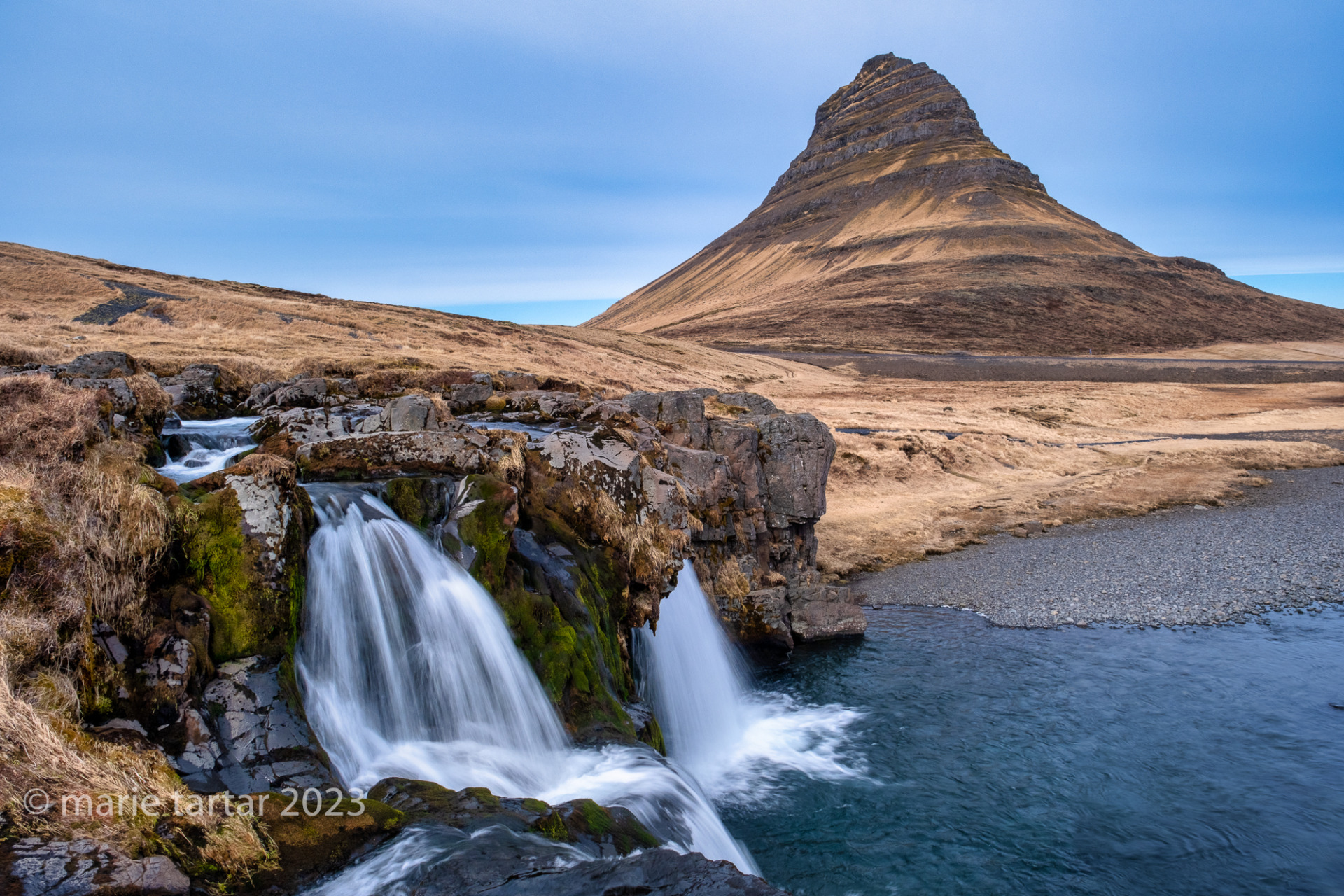
Iceland: an island country in the middle of the Atlantic Ocean, small in size, but with a lot going on. Volcanic activity formed it and powers it and intermittently, eruptions thrust it onto the world stage. We had great memories of two prior trips, both in July and had been wanting since our last trip in 2014 to return in a different season, so we could see the icy side of Iceland, especially ice caves. We were daunted by the prospect of going in full-on winter of short days and extreme cold.
Although we’d explored the south coast and the Snaefellsnes Peninsula on our prior trips, there was one beauty spot we had intentionally ignored, twice, even though it is an internationally famous and iconic dive destination: Silfra, where the continental plates of North America and Europe are slowly diverging, 2 cm/year. We had never been willing to drag our dive gear and underwater cameras there for a single day of diving.
When we celebrated Steve’s 60th birthday in 2017 with friends in Svalbard, the Arctic Circle archipelago north of Norway, our friends Bob and Debbie and Gerry and Nancy added on a circumnavigation trip to Iceland the week before joining us . We’d been surprised to learn that these experienced divers had been barred from diving Silfra, largely based on their age. They were unwilling to jump through the hoops of producing proof of drysuit competency and ended up snorkeling.

Diving in the divide between two continents in startling clear and cold glacial filtered water at Silfra in Thingvellir National Park in Iceland: unforgettable!
The current legal requirement for diving Silfra is proof of drysuit competency or 10 logged drysuit dives in the preceding 2 years. We learned to drysuit dive in the 1990s but I don’t think we ever received a card to prove it. We had put a lot of time, money and effort into preparing for a cold water dive trip in the fall of 2022 to British Columbia, so much that I thought we should get more use out of our new (Steve) and newly refurbished (me) drysuits. This Alex Mustard led trip was postponed 2 years by the pandemic. When I saw Alex had a dedicated Iceland dive trip, focusing on Silfra, on offer the following April, the idea for a return to Iceland on the presumably gentler shoulder of winter began to develop. Greg was on board immediately (he has actually ice dived, in Lake Baikal in Russia), but Steve was dubious and had to be, uh, persuaded. In April, there was at least one ice cave which would still be open to see and although late in the season, there was even a possibility of seeing the aurora borealis. We decided to add on a landscape photography week before the 5 day dive trip, as going any later in April would markedly diminish our aurora chances.
The trip was priced at 2260 pounds sterling (Alex is English), about $2840 US. Not cheap but Iceland is an expensive country and who better to go with than the man whose photographs thrust Silfra onto the world SCUBA diving stage?
Alex’s Icelandic counterpart, Byron Conroy of Arctic Adventures, was the point person for the Iceland operations. Arctic Adventures offers a full range of tours and activities, but after a phone conference with Byron, it was clear their small group (14 people) tours probably wouldn’t fulfill the needs of 3 tripod-toting landscape photography nerds. Byron was willing to personally guide us. Perusing his Instagram showed he is an outstanding photographer, both underwater and above (despite his protestations that he is not really a landscape photograph). Booking with Byron also solved a looming logistical problem, namely storing our dive gear and underwater cameras while we were on the land tour. The price of 495,000 Icelandic kronor (roughly $3650 US) for a week of private travel and guiding in Byron’s personal modified Toyota land cruiser seemed reasonable. By the end of 2022, we had a plan in place, with the major to-do item on our preparation list being acquiring dry gloves for the cold waters of Silfra. By mid-January 2023, I had redeemed 155,000 credit card points to score two free roundtrip economy tickets on Delta, flying through JFK (value $2333).
Saturday, April 8-Sunday, April 9, 2023
San Diego-NYC
Our ride share car was so full of gear and us that I sat up front with the driver, a Black man whose retirement plans to move to his wife’s native Panama, I quickly learned, were derailed by one of his three sons producing a granddaughter.
The first leg, to JFK, was comfortable enough, thanks to $60 per person exit row seat upgrades. I cried my paper mask to sopping watching The Notebook. Joey and Lorenzo are helping bring a musical version to Broadway later this year. More tears were elicited by a French film, La Brigade, in which a chef aspiring to have her own restaurant finds purpose in feeding and training immigrant boys to cook. The boys are in limbo, as they are residents of a home who await determination of their immigration status, .
NYC-Reykjavik
I binged on BEEF all the way across the Atlantic to Iceland. Not the marbled kind, but the intensely engrossing Netflix revenge series starring Steven Yeun and Ali Wong, who become embroiled in a road rage incident in the parking lot of a big box store. I had become hooked on this series in the week leading up to our departure, so hooked I downloaded the rest of the episodes to watch en route to Iceland, a first for me. This passed most of the time in a non-reclining seat one row in front of the exit row. On this leg, I definitely regretted economizing with this points fare.
We both found Delta old fashioned and frustrating to deal with: texts from Delta alerting to us to where our luggage was were one of the few progressive touches. After securing two weeks off for this trip, we were later able to confirm off several additional days, enough to stop off in New York on the return. Yes, Delta was willing to let us reschedule the final leg, that will be $2000-I don’t think so! I decided we would forgo our last leg on Delta and secured $200 tickets for a Jet Blue flight to San Diego 4 days later.
Greg beat us to Reykjavik by a few hours and caught the FlyBus into town. We joined him for a late breakfast at Eyja Guldsmeden, an attractive property with a dragonfly theme (another meaning of Guldsmeden is goldsmith).
We walked into town in a steady and determined rain, where Greg added to his already burgeoning and very international hat collection. After napping in the gloomy afternoon, Byron came to meet us in the lobby at 5 pm. He motioned across the street, saying that we’d be traveling in his car. A small silver sedan had us baffled how we would all fit, only to find he was referring to a beefed-up silver Toyota truck parked behind the car. He took our dive gear and underwater camera suitcases with him for storage for the week.
The persistent rain and looming jetlag fatigue (neither Steve nor I had managed any sleep on the journey) kept us in the hotel for an early dinner of a “sweet potato” soup (which proved to be a delicious savory pumpkin soup). The “vegano” panini was equally savory.
Monday, April 10, 2023
The 4 of us, with camera bags, tripods and suitcases, fit into the comfortable and capable souped up Toyota without difficulty. Byron manned the wheel, with Greg in the front passenger seat, me behind Byron and Steve behind Greg. We took in the “Golden Circle” en route to the night’s destination, Vik on the south coast. Steve and I had seen these marquee tourist attractions driving ourselves on our first trip, but they were new to Greg.
Our first stop was a preview of Silfra, the focus of the following week’s diving. It is within a historic site, Thingvellir National Park, the site of the first Parliament of Iceland and an early democracy. Also spelled Þingvellir , meaning assembly plains, the Alþing general assembly was established around 930 and continued to convene there until 1798. For 2 weeks in the summers, Icelanders would converge on this site.
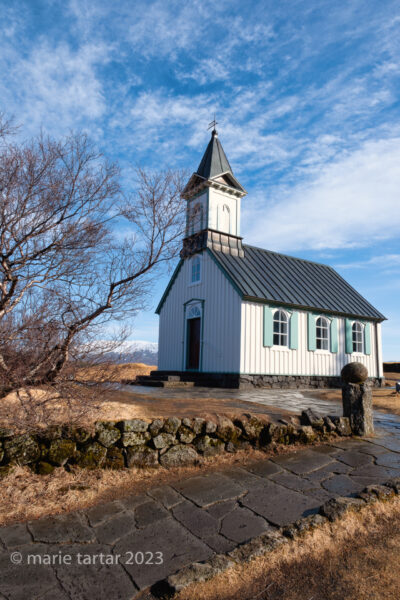
Christianity was adopted as the official Icelandic religion in the year 1000, at a time when conflicts between Christians and pagans threatened societal cohesion. This church at Thingvellir dates to 1859.

From a dreary rainy start in Reykjavik on Sunday, most of our subsequent land travels our first week included sun and nice clouds. These glassy waters are a short walk to the entry point for diving or snorkeling Silfra in Thingvellir National Park.
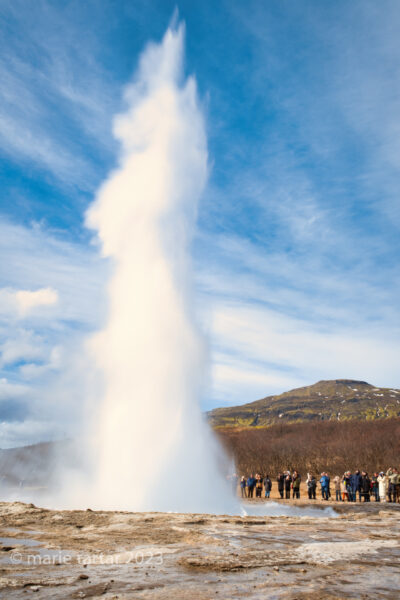
Our next Golden Circle stop was the geyser field. Geysir itself, the plume which lent its name to the word, is mostly dormant, but its neighbor, Strokkur, issues forth a dramatic eruption every 4-10 minutes without much warning for photographers.
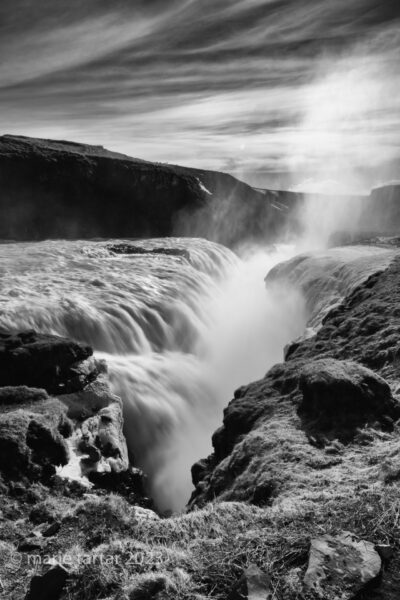
The final leg of our Golden Circle tripod of famous Icelandic tourist sights in easy reach of Reykjavik: the powerful and huge waterfall, Gullfoss (Icelandic for golden and foss means waterfall), formed by glacial runoff carving out a deep canyon in the Hvítá river.
We spent a windy and cold evening shooting the sunset near Vik. In one direction, the low angle of the sun highlighted rugged sea cliffs.
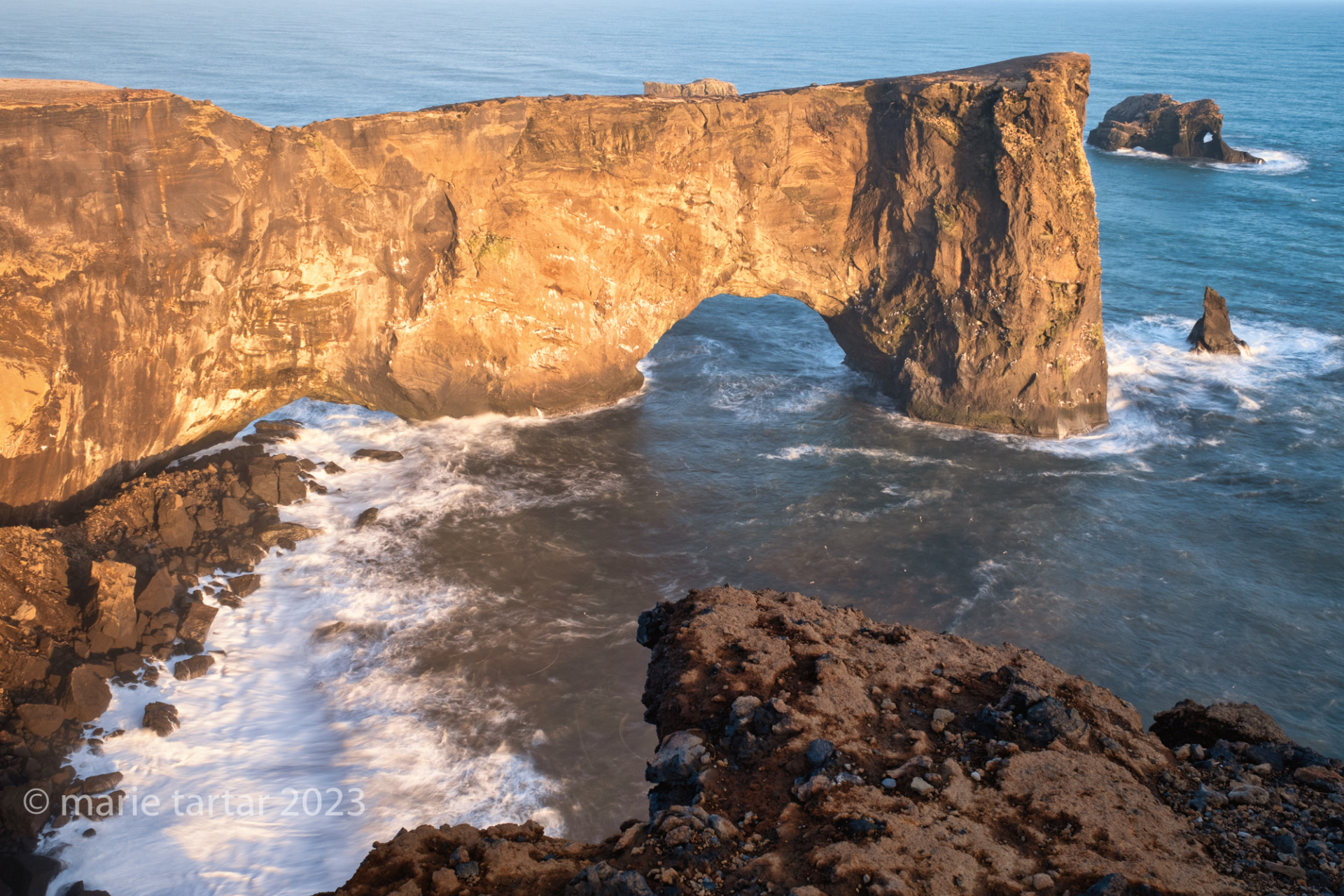
Even with a 9 stop neutral density filter, these turbulent waters being whipped by the wind at Dyrhólaey could not be calmed. We dared Greg to fly his drone (we didn’t bring ours) under this sea arch, but he didn’t bite.
In the other direction, the sun set over a seemingly endless expanse of black sand beach.
Byron chose our evening’s accommodation, Hotel Katla, for its location on the eastern outskirts of Vik, so as to get a jump on our early morning departure for the Katla ice cave. My Arctic char served with potatoes was a tasty repast and the first of a series of surprisingly good meals along the south coast, the general level of dining seeming to have risen considerably since our last trip 9 years before.
Tuesday, April 11, 2023
Byron’s plan to beat the crowds at the Katla ice cave was executed perfectly. We left at 6:30 am. Byron steered the vehicle (with tires deflated to manage the rugged, minimally marked road) expertly, landing us in the carpark hours before the first of many tours, each arriving with 14 helmeted tourists in tow.
We had the ice cave to ourselves for several hours. Byron had brought slip-on crampons along for us, which we donned before mounting an inclined approach. From there, we had a series of wooden boards to traverse, some with ropes alongside to grasp, some without. The river was running underneath the narrow bridges. It was quite dark when we arrived, dark enough I was unnerved to step off one wooden scaffold onto ground I couldn’t really see, only a couple of steps from the next wooden gangplank. It was a real luxury to have the cave to ourselves, especially with all three of us with tripods extended. Another luxury was having Byron willing to model, in a bright orange jacket he brought along for the purpose.

Byron Conroy: a great guide and guy, both topside and underwater, knowledgable and fun to be around, even willing to pose (Katla ice cave, Iceland). We were calling him Lord Byron by the end of our trip.
Steve left before Greg and I were done. It turned out he was having enough GI distress to feel vagal in the cave. He sensibly exited the cave lest the situation escalate.
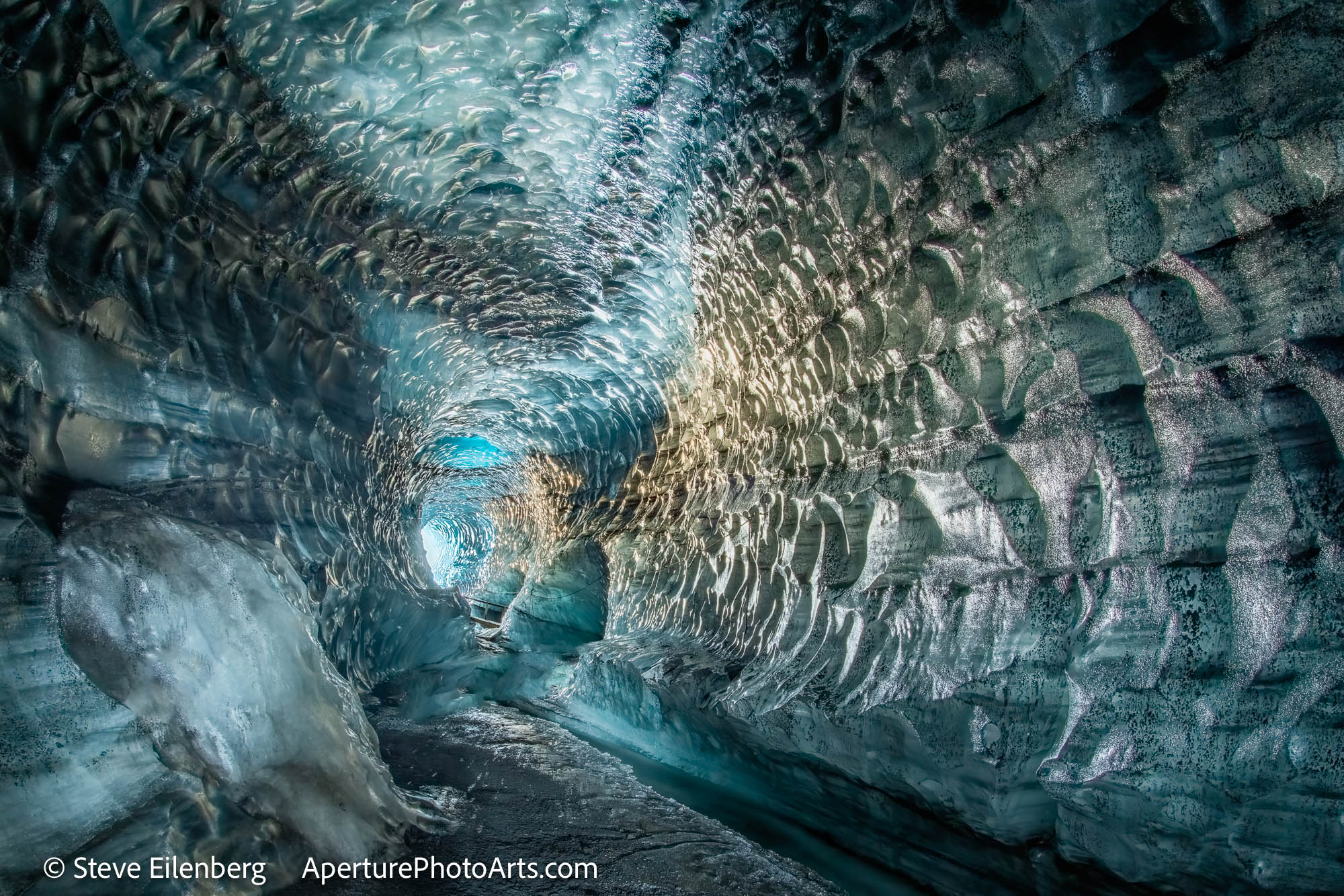
Queasy or no, Steve still managed to produce a lovely depiction of the amazing Katla ice cave. Ice caves are formed by melt water inside glaciers, forming a river that will seek a path out. Ice caves are dynamic, changing from year to year, sometimes even from day to day. The Katka ice cave has been in use for 5 years.
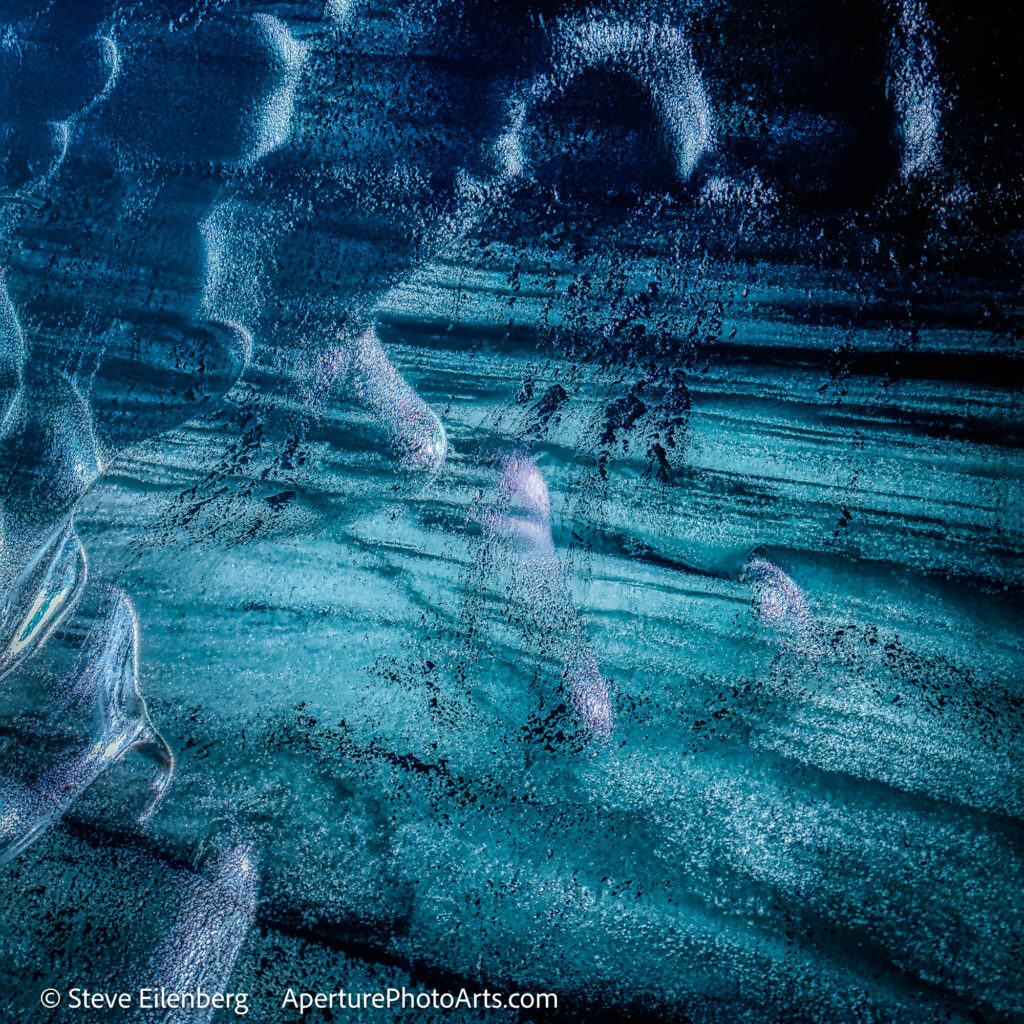
Close-up by Steve of the wall of the Katla ice cave. The sculptural effects of water on ice are otherwordly!
Lunch was at a cafe behind the Vik supermarket. The lamb sandwich was too cheesy and mayonnaise-y for me. Steve rehydrated with tomato soup. We pushed on to the east, arriving to Jökulsárlón by mid-afternoon. Jökulsárlón means glacier river lagoon.

A sublime sight: Jökulsárlón, the glacier lagoon on the south coast of Iceland (panorama stitched from multiple vertical images).
It is notable among proglacial lakes for communicating with the sea. Icebergs break off of Breiðamerkurjökull, itself a tongue off the massive glacier Vatnajökull, and are slowly washed through a lagoon before drifting down to the black sand beach we know as Diamond Beach.
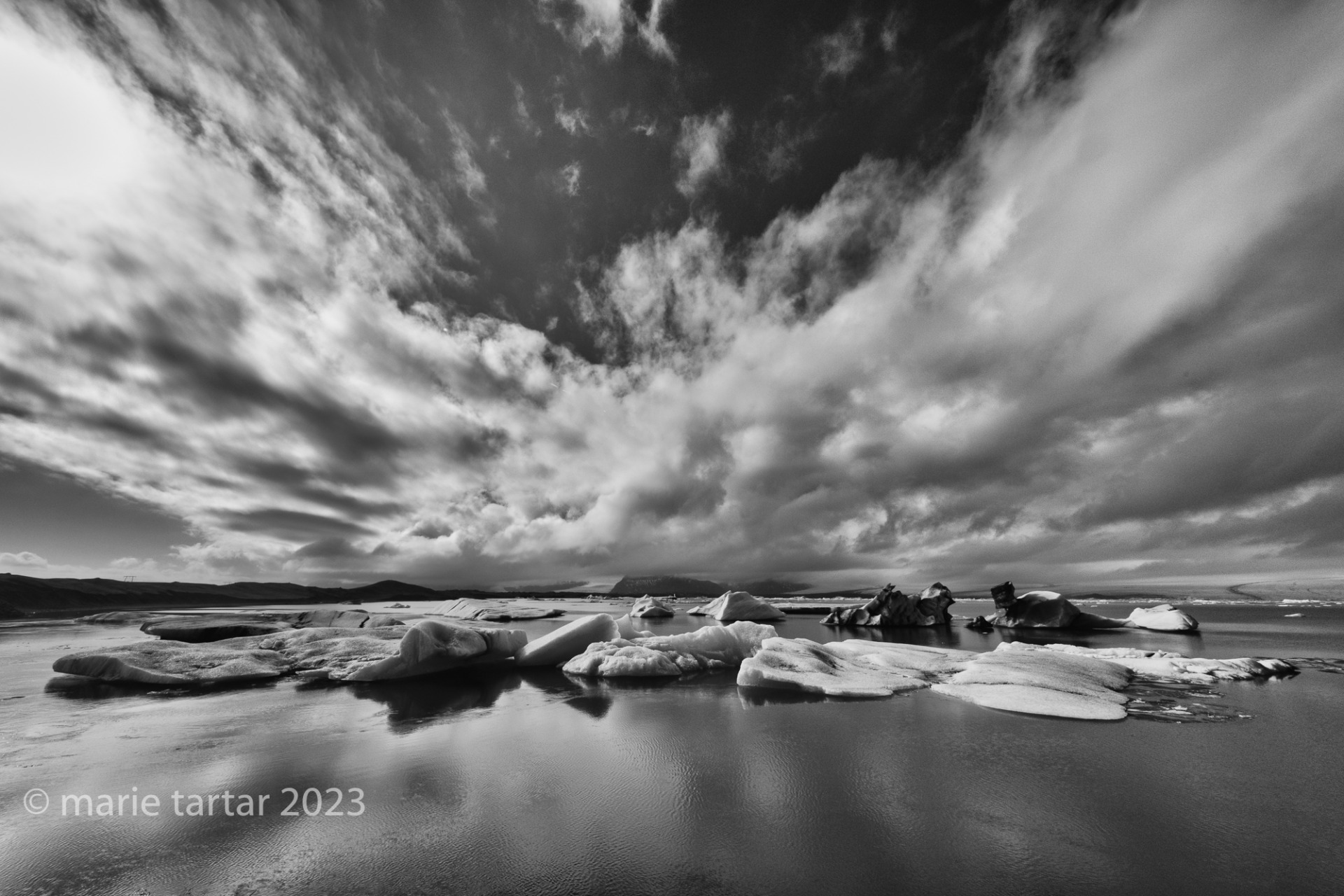
Even though the blues of the lagoon, sky and icebergs of Jökulsárlón can be quite beguiling, it also looks magnificent in black and white. This was taken with an 8-16 mm lens (at 8 mm) I found quite useful on this trip.
The beach was full of people and many more miniature icebergs than on our prior trip.
The car park was jammed across the street at the lagoon, but the clouds were glorious and the water mostly calm. Down by water’s edge, two young girls were fishing with small nets, slapping the otherwise smooth surface of the water in an annoying way (at least for a photographer trying to smooth the water) while their mother struggled into a rubber mermaid tail (I kid you not!).
We passed the night at an Arctic Adventures property, Adventure Hotel Hof. Greg quickly abandoned his recently adopted vegetarian “intention” and followed Byron’s suit with the lamb shank.
Wednesday, April 12, 2023
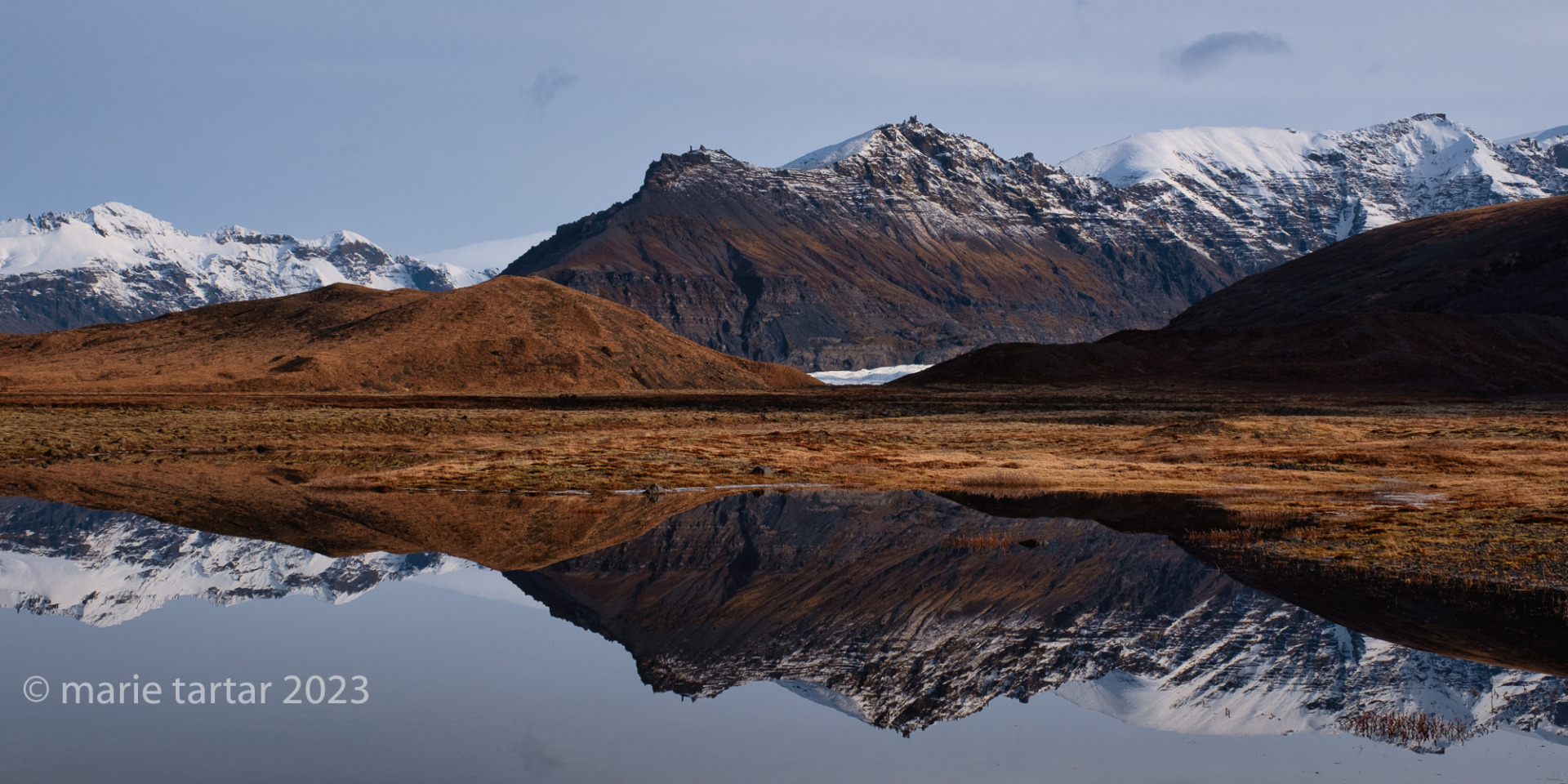
This Rorschach like glassy reflection made us pull off for a quick stop en route to a glacier walk rendezvous with Oliver.

That and this beautiful frozen ice edge! Near Falljökull glacier, a tongue of the mighty Vatnajökull glacier, south coast, Iceland.
After an unmemorable breakfast recalling to me my hostel days traveling in Europe with a backpack before medical school, we drove over to Skaftafell to meet up with Oliver, our guide for the glacier walk, a lanky 23 year old experienced alpinist. He fitted us with hefty ankle bracing hiking boots and much beefier crampons than either stored away in the soles of our newly acquired Pajar boots or that we donned for the ice cave excursion. The crampons were threaded over ice axes, which function much like a short walking stick, for the hike up switchbacks to where the glacial ice began. Our instructions were clear: up, out, down with each step, stamping our feet into the crispy spring crust, while avoiding impaling our other calf and other people. It was sunny and knowing we had a climb to start, we pared down our clothing in order to “start cold”.
Lunch was an uninspiring chicken biryani, despite young Oliver’s endorsement. Byron pledged to take him out for an educational “real meal”. I may have inadvertently dined and dashed at this establishment. If so, this wasn’t an intentional inditement of the food quality. While the others were procuring food from the cafeteria style establishment, I went to the restroom. Returning, I found they had all gone for the biryani but did they warn me of its listlessness? No, they did not! I procured the chicken version (basically the vegetarian version plus some uninspiring chunks of chicken, the vegetables were mere suggestions of color within the rice) and came over to the table with my tray. I assumed Steve had paid for me as the choices were rather limited, so was surprised when after we left, somehow this incident morphed into me being dubbed “Whiskers”. It’s a stretch but as near as I can figure, it goes something like this: Dine and dash vs. inadvertently not paying for a lackluster meal nearing its prime=cat burglar=puma (a standing joke from Patagonia)=Whiskers (new nickname, go figure). I should mention here that Iceland is virtually cashless. We found ourselves paying even for tiny purchases (a coffee, thicker gloves) with credit cards. I had left my Apple watch at home (one more device to charge) so sometimes didn’t readily have the means to pay (my credit cards buried in my tote, along with extra gloves, a buff, fleece hats of different weights, drinks, lip balm and thousands of other daily essentials). Steve and I never did exchange any US dollars for Icelandic krona during the entire 2 week trip.
We broke up the drive east with a stop for a walk and to shoot a glacier lagoon, Svinnafjell, where Greg flew the drone.
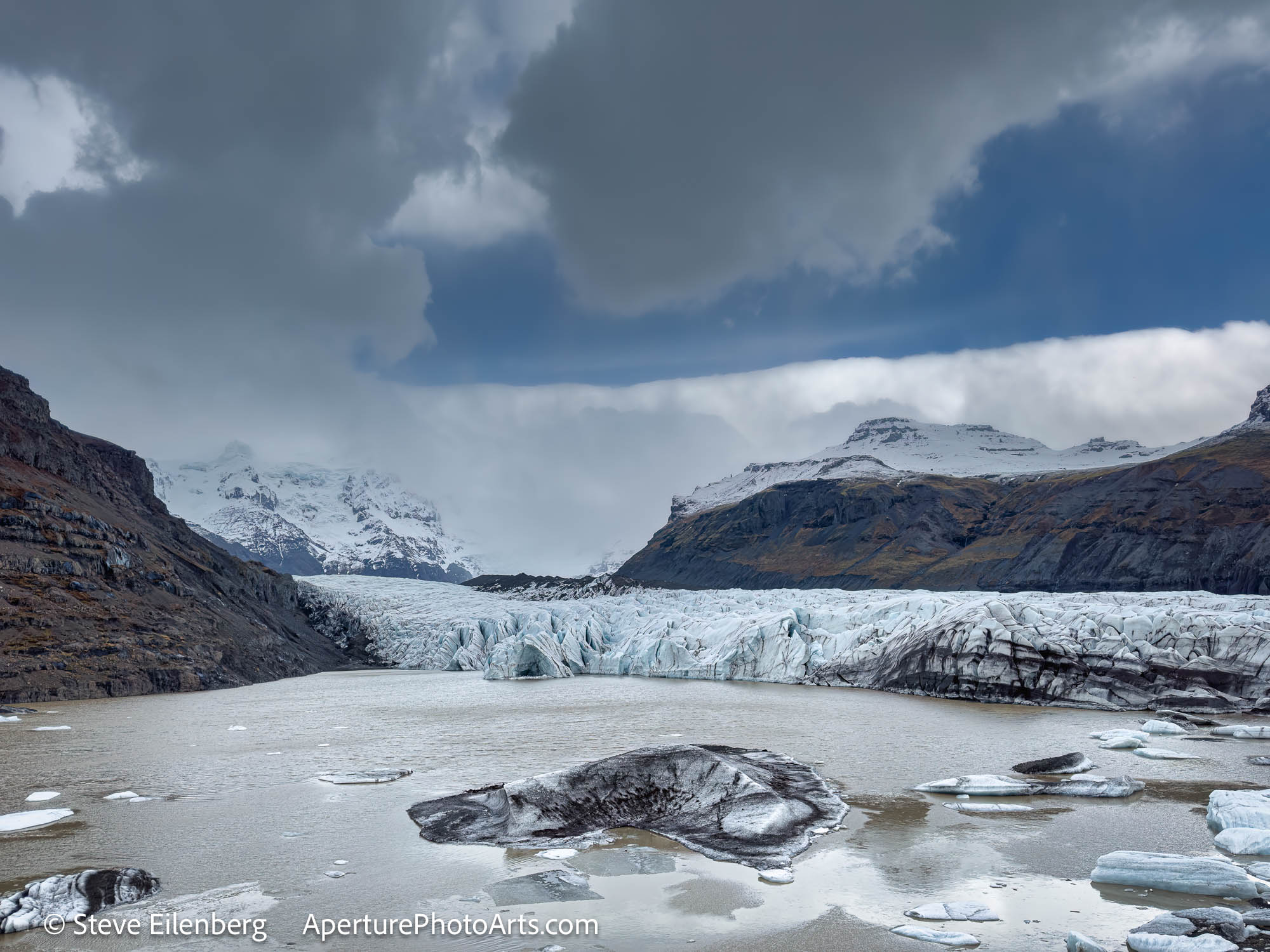
The glacier lagoon at Svinnafjell is more typical in coloration, with brownish water. The communication with the ocean at Jökulsárlón distinguishes it.
The rain waited to start up as we left for the remaining 2 hour drive east to Höfn. After checking into the Hotel Höfn, we had an early dinner at the hotel’s restaurant, Ósinn, prior to heading out to shoot the sunset at Vestrahorn. I took a page from Greg’s occasional and opportunistic vegetarianism, enjoying my cauliflower steak and roasted vegetable dish more than Steve did his Parma pizza (“too big and too much ham!”).
Vestrahorn is a mammoth mountain formation rising dramatically up on a peninsula. The thin sheet of water we were hoping for as a foreground wasn’t to be, but there was nice golden light and capricious clouds. In places, we were sinking near full foot into the wet black volcanic sand which fortunately wasn’t gooey.

Steve went to some trouble to electronically eradicate the many footprints marring this foreground view of mighty Vestrahorn, southeast Iceland.

Icelandic horses on a ridge leaving Vestrahorn nuzzle each other as the sun sets on another great day in Iceland.
Back at the hotel, we warmed up in the bar, Steve and Greg nursing Einstock beers. The lobster soup Byron ordered looked so good, I ended up succumbing to its savory lures as well. This was the furthest east we would explore this trip. On our prior trip with Chris Lund, we made it as far east as Jökulsárlón.
Thursday, April 13, 2023
Sadly, it was time to reverse course and retrace our steps driving back west along the coast, with Vik as our evening’s destination. Icelandic horses grooming each other along an accessible fence brought us quickly to a halt.

Icelandic horses sporting thick winter coats nuzzle each other. (Ring Road, west of Hofn, south coast of Iceland)

Svinnafjell glacier, a nice place for a leg-stretching walk, with an amazing glacial formation recalling the Sydney Opera House. Greg sent the drone aloft again.
Hamrafoss called out to us from the road. Our car being pulled over was enough to cause a chain reaction with others pulling over.
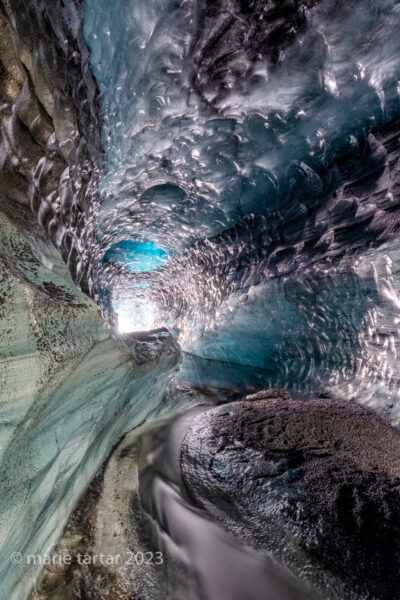
Katla ice cave, a kaleidescope of color, in southern Iceland, is a black ice cave, with the black color caused by volcanic ash falling on snow while the ice is formed. It forms only where frequent eruptions cause frequent ash falls. It located in the Kötlujökull glacier, a glacial tongue of Iceland’s fourth largest glacier, the Mýrdalsjökull glacier. It is the only ice cave open all year round; others can only be visited in winter.
We had so enjoyed our sojourn in the Katla ice cave that we elected an afternoon return to it. We had more company than on our early morning visit, but it was late enough in the afternoon that there were only a few groups of visitors to work around.
Our evening accommodation was a hotel new to Byron, with an excellent restaurant. The Hótel Vík í Mýrdal is a sleek, attractive modern stone, glass and concrete structure, designed by Icelandic architect Guðbjörg Magnúsdóttir. We had a lovely meal at the Berg restaurant. My seared scallop starter was a highlight (with fennel, buttermilk dill emulsion, pickled cauliflower, and Icelandic kelp), although Steve was less enthused with his lamb terrine. I helped Greg with his dessert of chocolate cremeux, flavored with caramel, hazelnut sponge and yuzu gel.
Friday, April 14, 2023
Our last southern coast travel day was beautiful, cool and sunny. Byron started us off at an impressive waterfall, Kvernufoss, our arrival timed to take advantage of the good weather for a ferry ride and visit to Vestmannaeyjar (Western Islands).
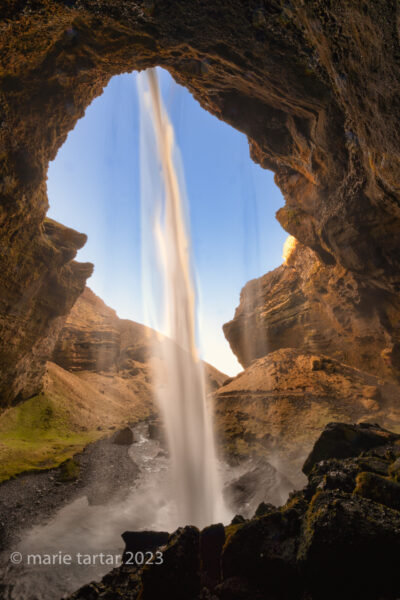
Kvernufoss: A beautiful waterfall reached by a short walk to a mossy gorge. This was a challenge to process: flare, water droplets, extremes of exposure, it had everything to deal with and no easy fixes. In retrospect, this is probably one of those sights better experienced than photographed but I do like a challenge!
While we were at Kvernufoss, Greg discovered he had left his wallet back at the hotel, now 45 minutes away and in the wrong direction. We had a timed reservation for the ferry and it was too late to double back. Quick thinking Byron had the problem solved within a few minutes, calling another Arctic Adventures guide who would be in the area later in the day. By nightfall, Greg had his wallet again.
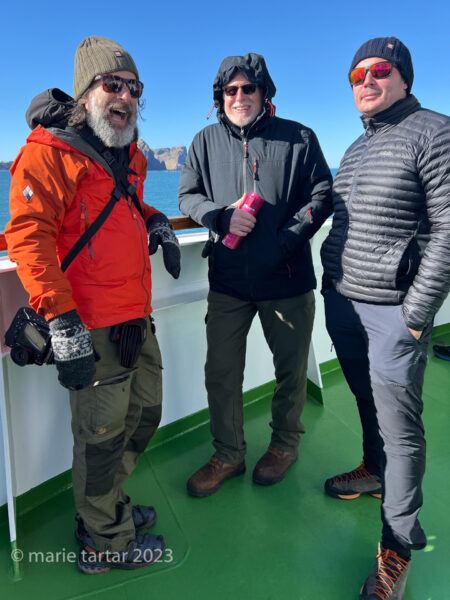
On the ferry to Heimaey, an entertaining trio with which to travel: Greg, Steve and our fearless leader, Lord Byron.
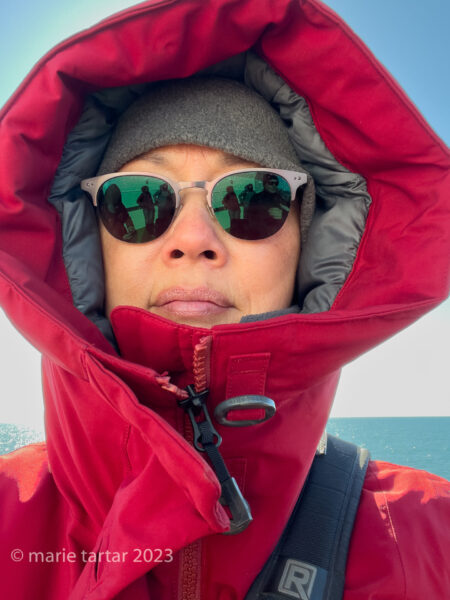
I was pretty bundled up for much of this April trip to Iceland (on the ferry to the Vestmannaeyjar).
A 45 minute ferry ride landed us on Heimaey, the largest and only inhabited island of the Vestmannaeyjar (Western Islands), an archipelago off Iceland’s south coast, formed by underwater volcanic eruptions. The youngest of the Vestmannaeyjar islands, Surtsey, was formed by an underwater volcanic eruption beginning in 1963 and continuing intermittently until 1967. It is uninhabited and serves as a living laboratory, with scientists monitoring it over time to track the slow process of vegetation and support of animal life (5 species of birds now nest on the island). The island’s name refers to Surtr, fire giant of Norse mythology.
Heimaey has 2 volcanoes, Helgafell and Eldfell.
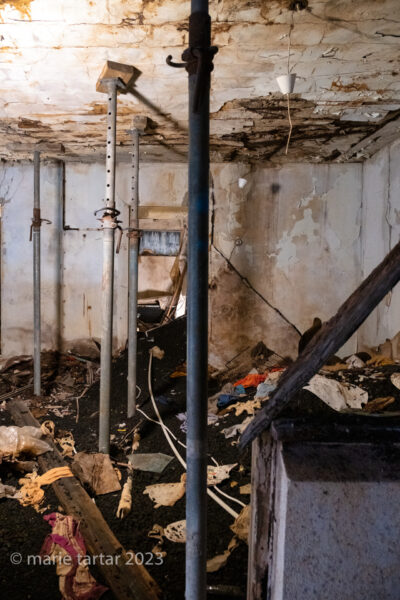
Destruction on an epic scale is vividly depicted at the Eldheimar Museum in Heimaey Town in the Vestmannaeyjar (Western Islands), a volcanic archipelago off Iceland’s south coast. This house was buried and the museum was built around the excavated remains.

Another view of the excavated house around which the Eldheimar Museum in Heimaey Town in the Vestmannaeyjar (Western Islands) was built. Volcanic ash fills the hallway, bringing to mind the sand dunes reclaiming abandoned diamond miner’s houses in Namibia.
Eldfell erupted in the middle of the night on January 23, 1973, leading to evacuation of the residents. Fortunately, inclement weather the day before kept the town’s fishing boats in the harbor, so when needed to transport the residents to the mainland, they were there. Interactive displays at Eldheimar Museum, in Heimaey Town, chronicle the devastation, when some 400 buildings (about 1/3 of all the island’s structures) were destroyed. The museum is built around an excavated house which was buried by the eruption, which continued until July 3. The museum’s displays are activated on approach to the different galleries and tell a compelling story of the town being shaken awake, quickly engulfed and evacuated and the long aftermath and rebuilding. The residents were relocated and many never returned. Not all of the effects of Eldfell’s eruption were bad: the harbor was reshaped and improved, better protecting the town.
It was the perfect day for a ferry ride and whirl-wind tour of Heimaey. Byron brought the car on the ferry with us and with it, we hit Elephant Rock and a cliff frequented by puffins in summer.
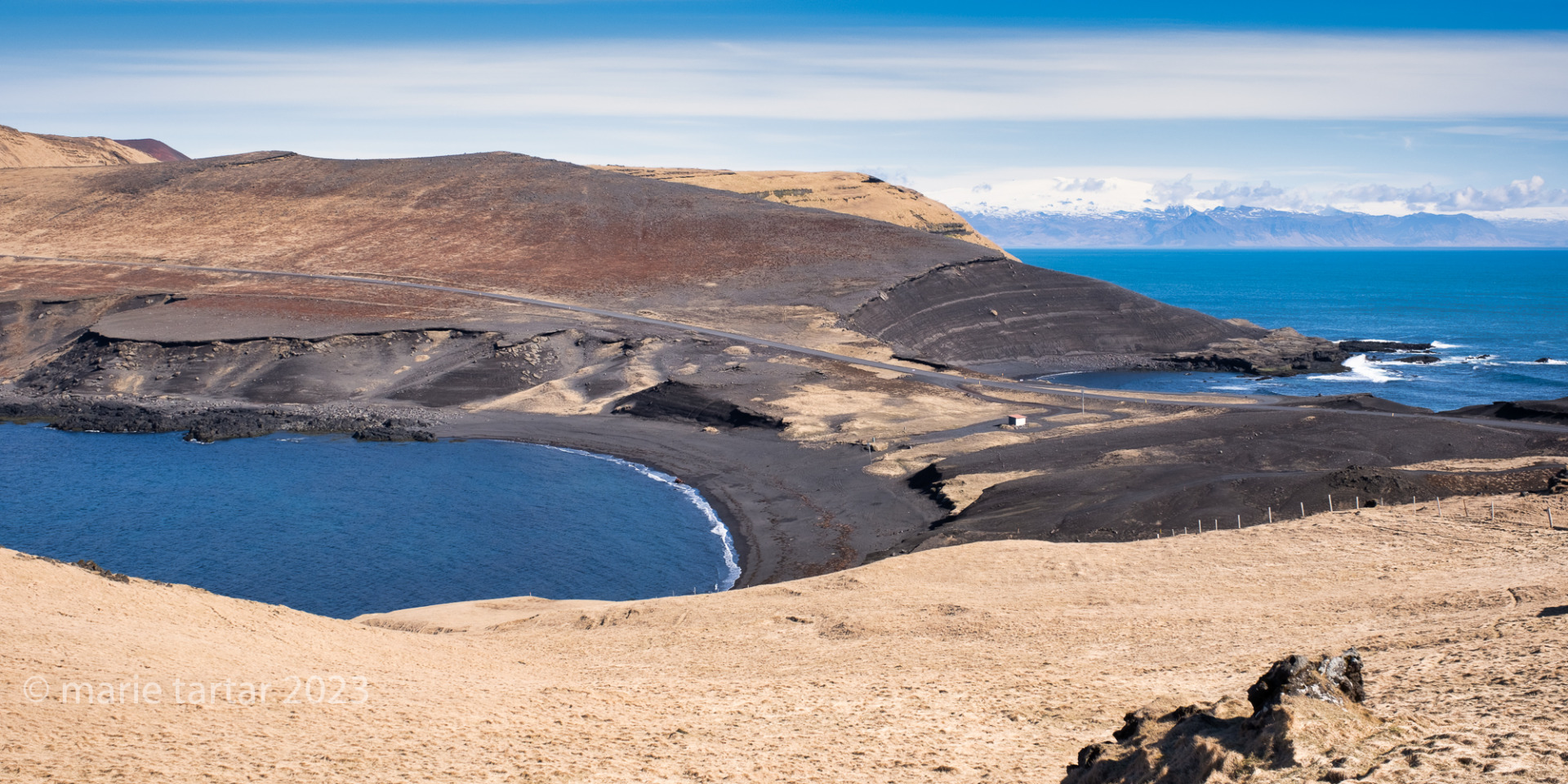
The volcanic nature and crater forms of Heimaey Island are evident here; the snow-covered peaks of mainland Iceland’s south coast are seen in the distance.
After lunch at Gott restaurant, the final stop of our Heimaey-in-a-day tour was Skansinn, a historic site.
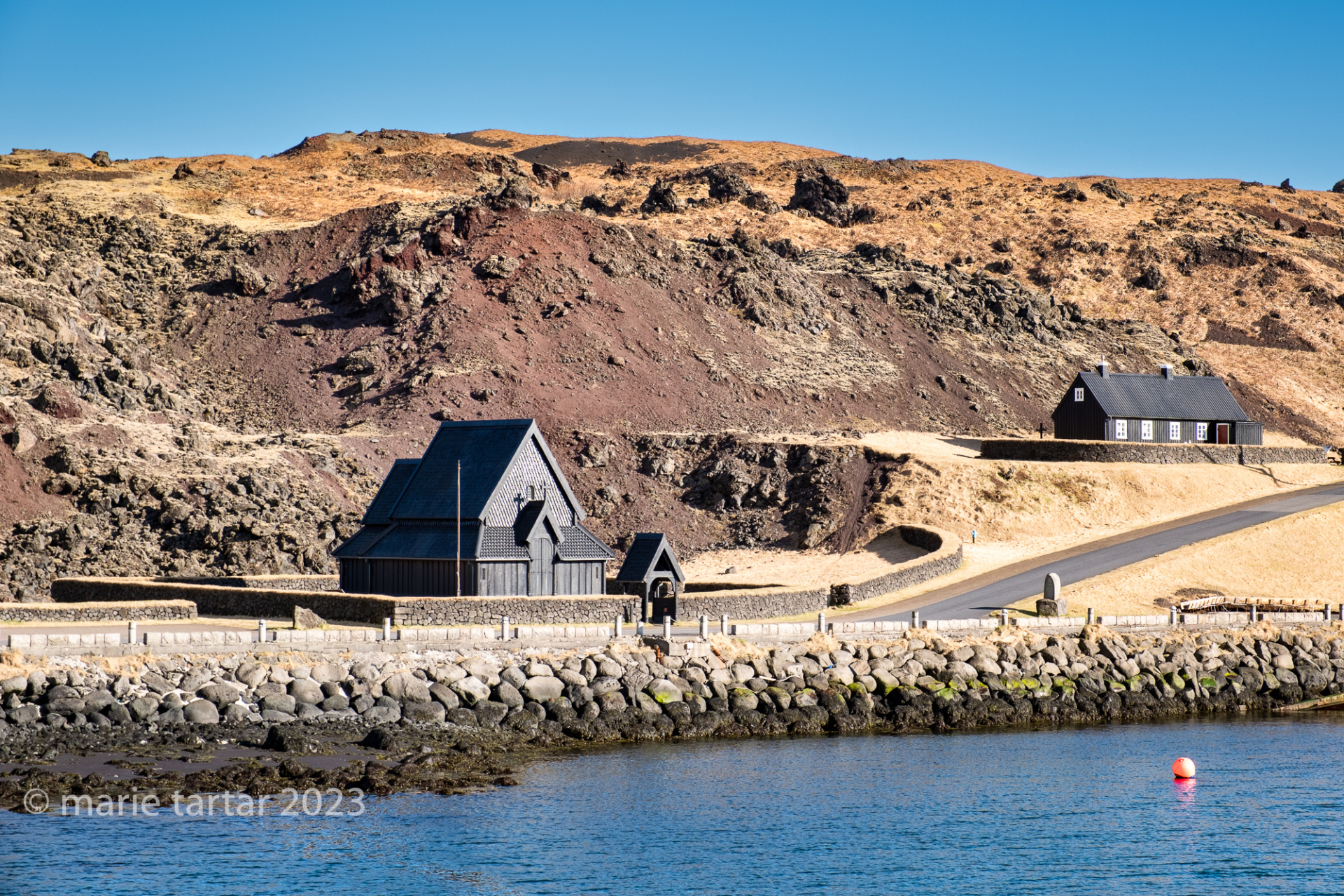
Skansinn, a historic fort on Heimaey Island, now houses a replica stave church from Norway (left) and a medical museum (right), sadly closed during our visit.
Skansinn means fort, which it was, built in 1586 to defend the Danish king’s interests from the British. In the years after 242 of the island’s residents were kidnapped for the slave trade by Algerian pirates in 1627, the fort’s defenses were beefed up, with a series of sentinels posted to keep a look out for intruders. This continued until 1700 . As recently as WW II, the site served as a British army outpost.

This handsome replica of a stave church at Skansinn, donated by Norway in 2000, marks Iceland’s 1000 years of Christianity.
We had a happy artistic discovery there, reconnecting with a mid-century artist whose work we had admired on a prior trip, Ger∂ur Helgadóttir.
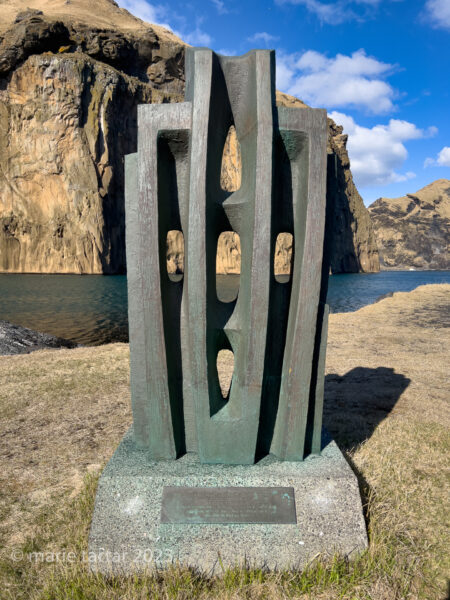
This handsome mid-century style sculpture caught my eye at Skansinn. Sure enough, this is a piece by Ger∂ur Helgadóttir, whose work we had admired on a prior trip. See more of her oeuvre in this post.
To cap off an amazing day, Byron had promised us a second waterfall behind which we could walk: Seljalandsfoss! Our return trip on the ferry and arrival at Seljalandsfoss was again perfectly timed, well in advance of sunset, with enough time for a bowl of lamb soup at the kiosk in front. But first, Byron had another surprise up his sleeve: Gljúfrabúi, an enclosed waterfall west of Seljalandsfoss and a short walk away. His assessment was correct: a waterfall to enjoy but almost impossible to photograph well, with unavoidable and constant spray, as this video snippet will attest. We had to settle for quick Iphone shots.
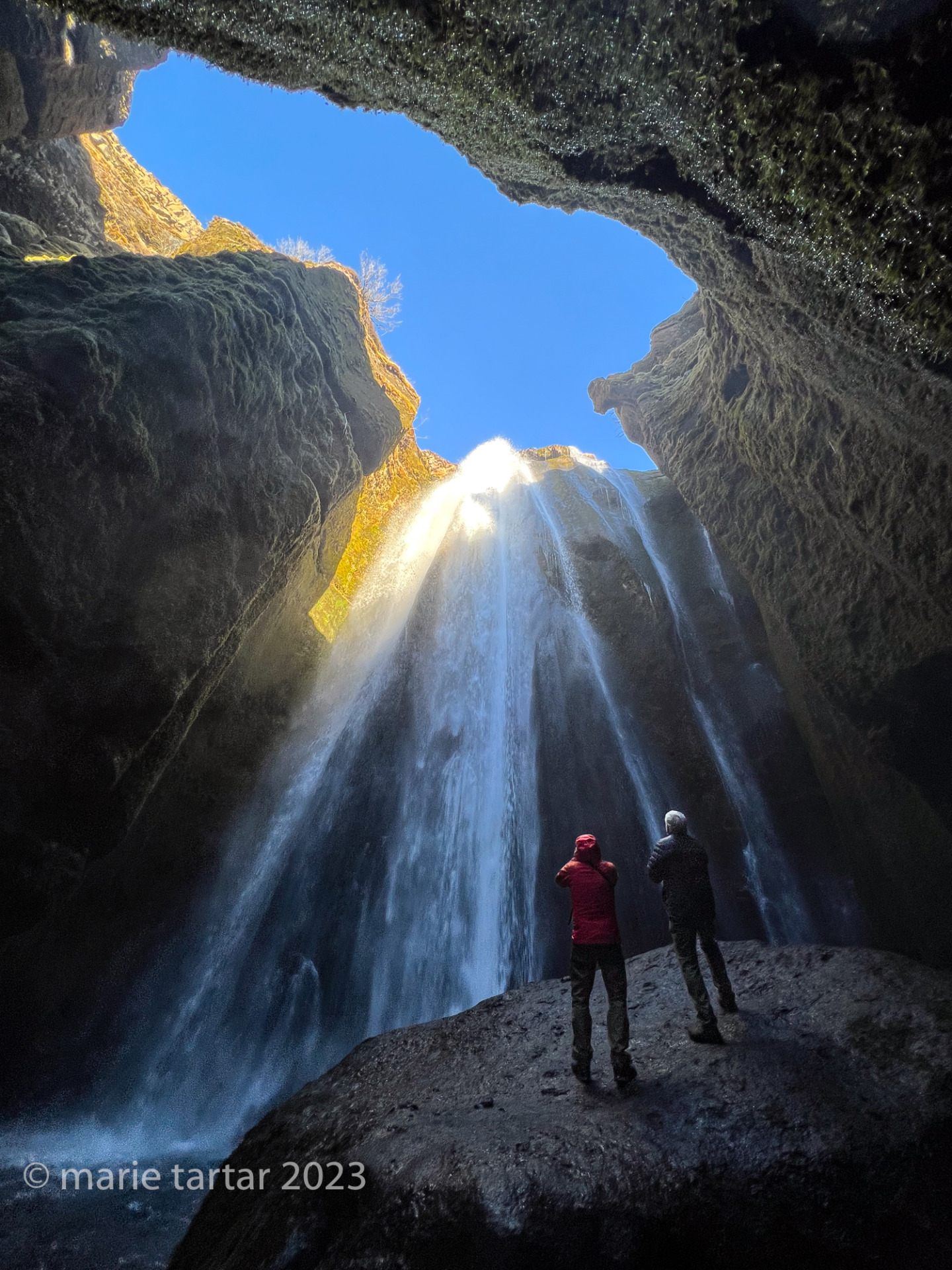
Iceland is full of surprises! This hidden waterfall pouring into a cave is a short walking distance from a famous and well visited waterfall, Seljalandsfoss, but has a fraction of the traffic. The constant spray makes Gljúfrabúi very difficult to photograph with any camera but the Iphone.
Seljalandsfoss is a huge torrential waterfall, with a path making walking behind it relatively easy (even picking one’s way carefully through puddles and rocks while laden with a tripod and camera backpack). It is impressive and gorgeous and as the gold light of afternoon slowly waned and warmed, the torrential falls began glowing pink with the sunset.
It was a splendid finale for a fantastic week exploring Iceland’s south coast, a treasure trove of sights, sounds and tastes. We struggled to stay awake on the drive back to Reykjavik, hoping the northern lights would make an appearance. Byron left us off at Hotel Skuggi in Reykjavik, our base for the following week’s Silfra workshop. By now, I was feeling reassured we were in good hands for the cold water adventures to come and not too far over our heads. We still had a weekend before the start of the diving, divided between a day with Byron exploring the Snaefellsnes Peninsula and a Sunday in Reykjavik on our own,an interlude to be continued in Part 2.
-Marie


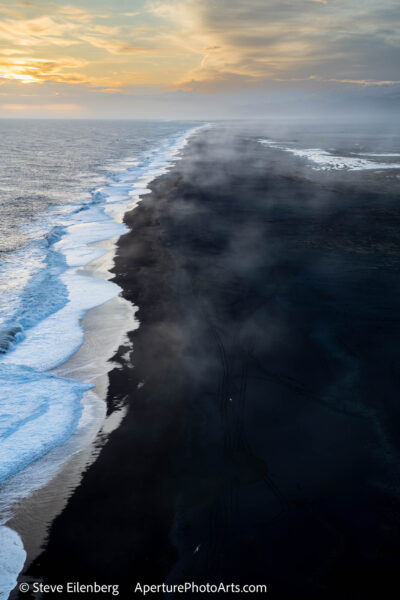
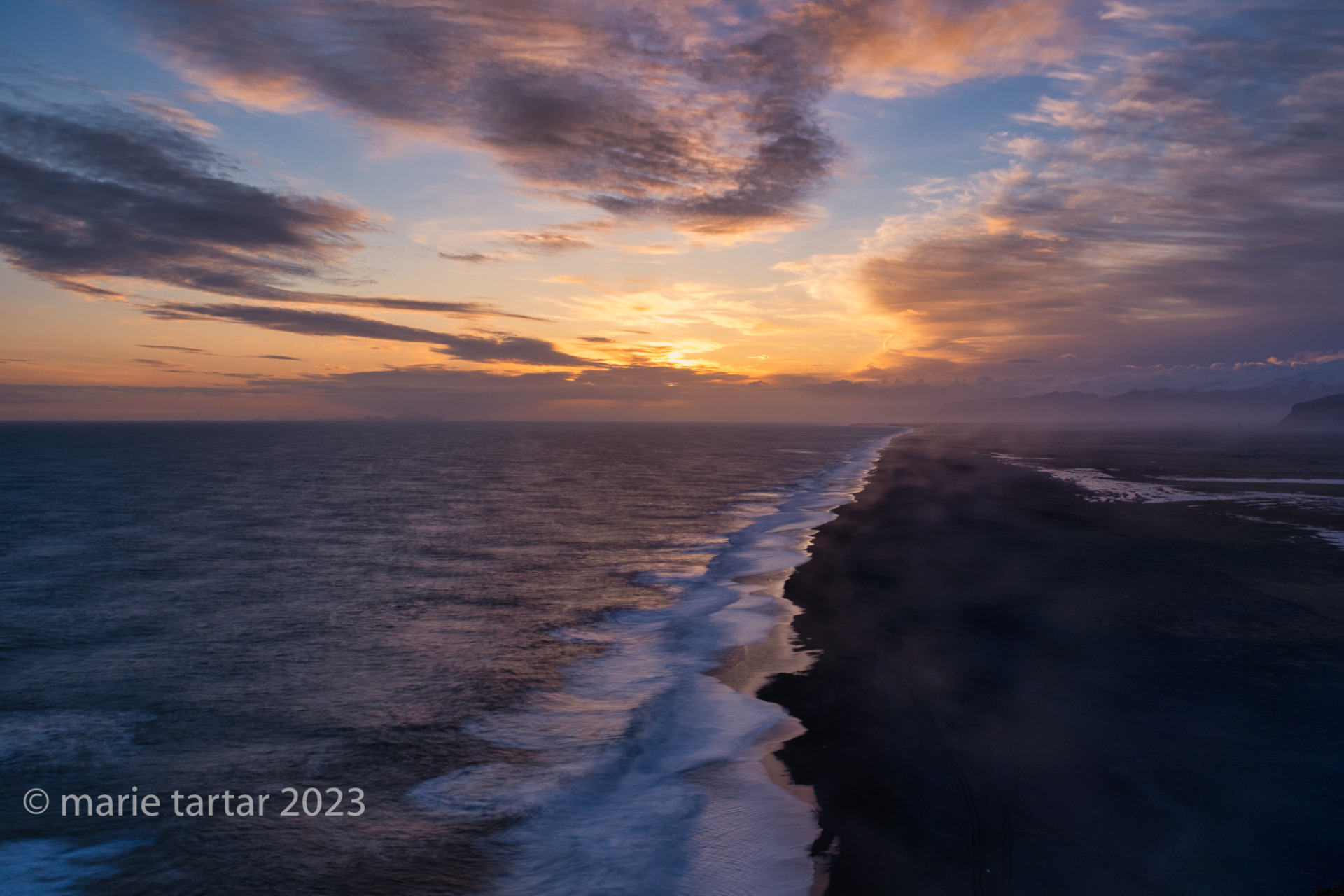
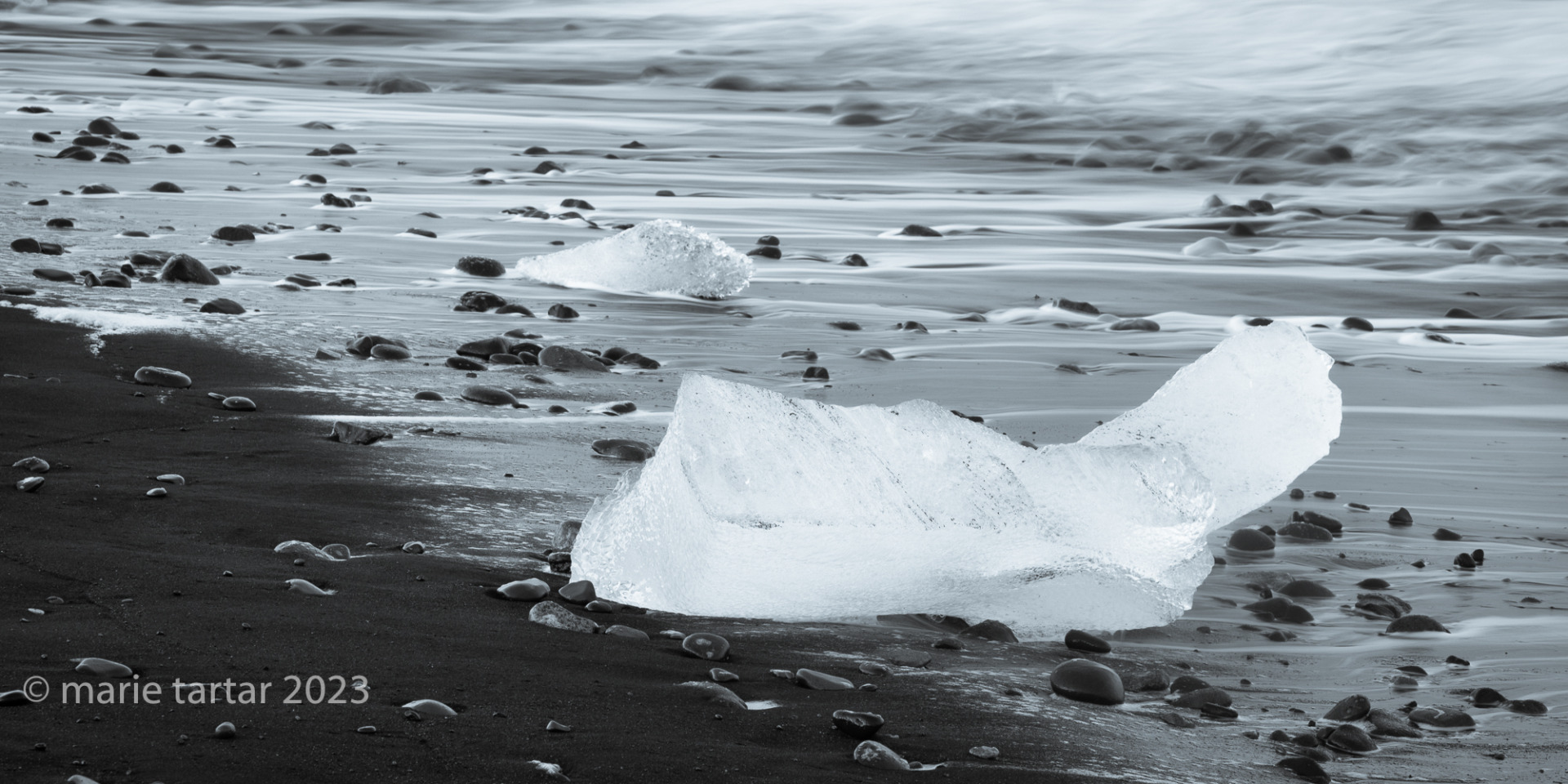


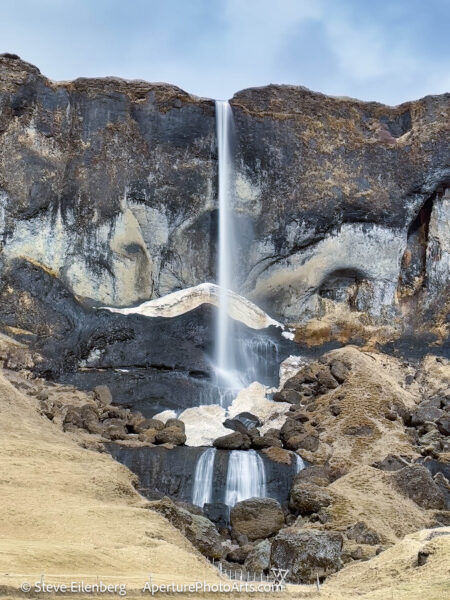
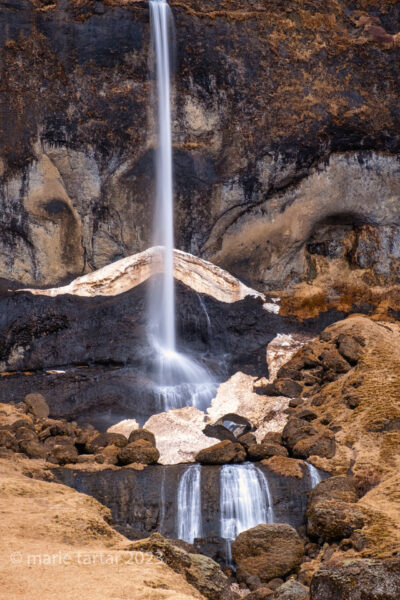



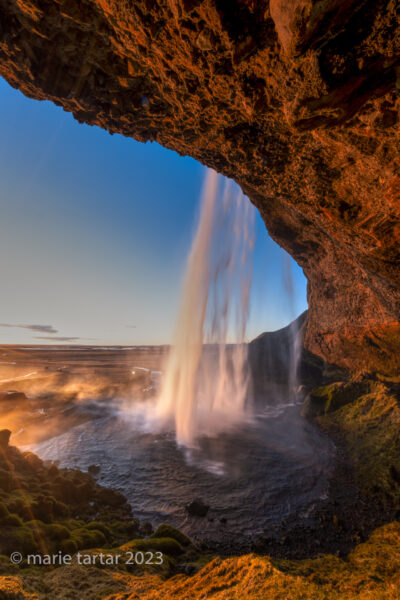

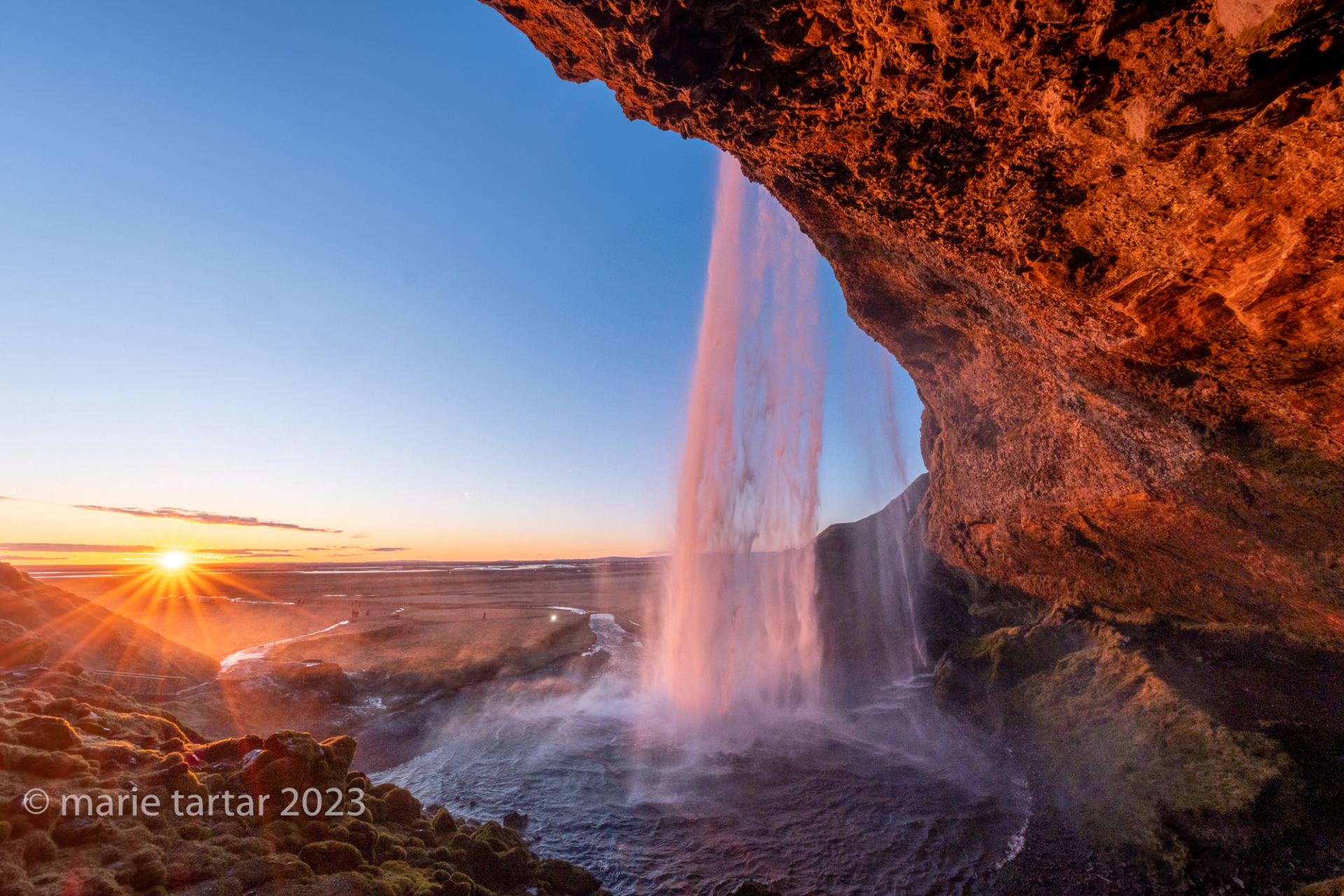
Again a magnificent blog, Marie!
I love your photos.
In August this year, Monica and I will go on an expedition cruise to Norway, Iceland and Greenland.
It is not a photography trip, but I hope to get at least a few good ones.
Say hello to Steve from me and keep well.
Jan
Thanks Jan, You are in for a treat this summer. Greenland is in our sights for a future photo trip one day!
-Marie